3. Insect Orders: Gradual Metamorphosis
Insect Orders with Gradual Metamorphosis
Listed below are the most important insect orders found in Kentucky gardens that have gradual metamorphosis. The next section, Insect Orders II: Complete Metamorphosis, covers the remaining insect orders that are part of the Kentucky Master Gardener curriculum.
Orthroptera (Grasshoppers, Crickets, and Katydids)
Orthoptera are medium to large-sized insects with gradual metamorphosis and chewing mouthparts. Most adults have two pairs of wings. The front wings are narrow and leathery; the triangular hind wings are membranous and fold like a fan underneath the first pair. The antennae are visible and may be very long. Many of the insects in this order are distinguished by their enlarged back legs which are modified for jumping. Most insects in this order are not pests, but some grasshoppers are general feeders that can eat the foliage of many plants. They rarely cause serious damage in gardens, however.
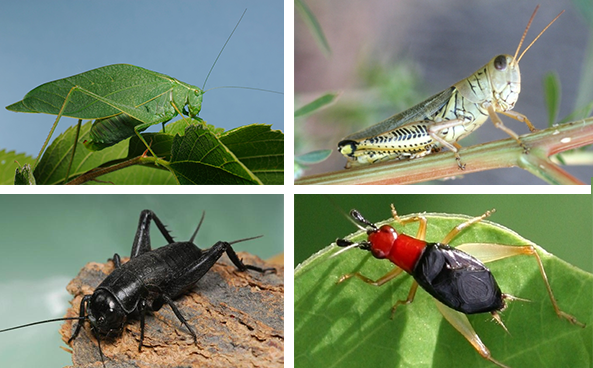
Common members of Orthoptera in Kentuck. Top row: Katydid (photo: Joseph Berger, Bugwood.org), Shorthorn Grasshopper (Whitney Cranshaw, Colorado State University, Bugwood.org). Bottom row: Field Cricket (Joseph Berger, Bugwood.org), and Bush Cricket (Johnny N. Dell, Bugwood.org)
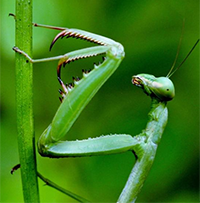 Spiny Front Legs of a Praying Mantis (Johnny N. Dell, Bugwood.org)
Spiny Front Legs of a Praying Mantis (Johnny N. Dell, Bugwood.org)
Mantodea (Praying Mantids)
Mantids are generalist predators that capture and eat many kinds of insects. The two front legs, which are spiny, enlarged and specialized for grabbing prey, help to distinguish them from other insects. These insects have keen vision and a neck that allows the head to rotate 180 degrees, making them good ambush hunters. Camouflage coloration allows mantids to blend in as they sit on twigs and stems watching for movement and waiting to grab prey. Kentucky has three species—the European, Carolina, and Chinese mantids.
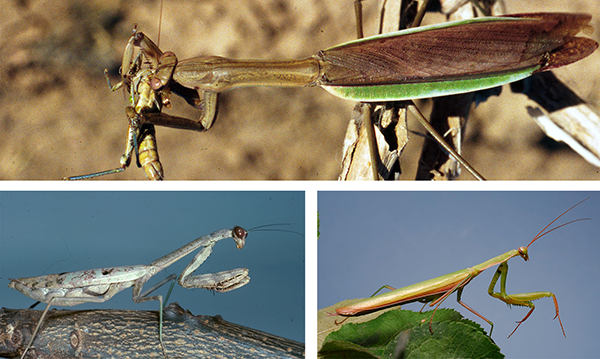
Kentucky's three mantis species. Top: Chinese Mantis (Whitney Cranshaw, Colorado State University, Bugwood.org). Bottom row: Carolina Mantis (Sturgis McKeever, Georgia Southern University, Bugwood.org), and European Mantis (Joseph Berger, Bugwood.org)
Blattaria (Cockroaches)
The flat body and long antennae of the cockroach are among the features that make this insect widely recognized. Wood roaches are sometimes found under debris but are not important pests in gardens.
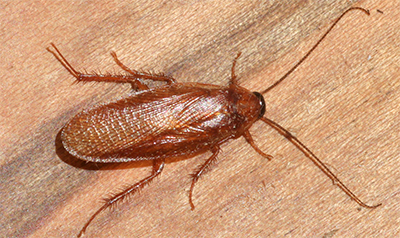
Wood Roach (Whitney Cranshaw, Colorado State University, Bugwood.org)
Dermaptera (Earwigs)
The pair of large pinchers at the end of the abdomen make earwigs easy to recognize. Earwigs are primarily scavengers. They are rarely important pests in gardens but may feed on plants occasionally. They are common under rocks or wood placed on the ground.

The European Earwig is a common species in gardens (Gary Alpert, Harvard University, Bugwood.org)
Thysanoptera (Thrips)
These insects are tiny (1⁄15 inch long) and slender, with two pairs of narrow, fringed wings (or none). Because they are very small and hide in concealed parts of plants, thrips are rarely seen, but the damage from their rasping-sucking mouthparts can disfigure flowers and foliage. Thrips usually feed on or in developing leaf or flower buds, where they tear at the tissue with a sharp mouthpart and feed on the sap that wells up. Injured tissue often is speckled with white or silver, and some species’ damage causes puckered leaves. Some thrips are important carriers of plant viruses, such impatiens necrotic spot virus. A few species are predators.
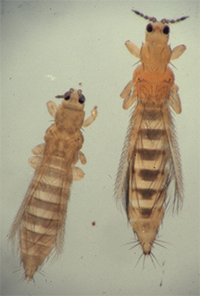
Onion Thrips (Alton N. Sparks, Jr., University of Georgia, Bugwood.org)
 Hemiptera (True bugs: Stink bugs, Plant bugs, Lace Bugs, etc.)
Hemiptera (True bugs: Stink bugs, Plant bugs, Lace Bugs, etc.)
This is a large order with many important garden species. True bugs have long, piercing-sucking mouthparts attached at the front of the head. The base of the front pair of wings is thick and leathery; the tip is thin and membranous. The wings lie flat over the back, and the membranous portion of the front wings overlap. Wingless nymphs can be identified from the mouthparts. Many true bugs feed on plant sap. Often, there are no visible symptoms of their damage, but some leave tiny white spots where they have fed, and some species’ salivary secretions may cause large spots or distorted tissue. Several hemipterans are beneficial predators in the garden, including assassin bugs, damsel bugs, and some stink bugs. Shown to the right are typical piercing-and-sucking mouthparts in this order (R. Bessin, University of Kentucky).
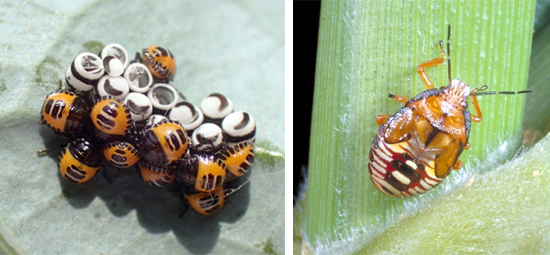
Typical eggs (Harlequin Stink Bug, Whitney Cranshaw, Colorado State University, Bugwood.org) and nymph (Spined Soldier Stink Bug, R. Bessin, University of Kentucky) of insects in Hemiptera.

Three plant-feeding stink bugs that can be pests in the garden: Brown Marmorated Stink Bug (Susan Ellis, Bugwood.org), Southern Green Stink Bug (Johnny N. Dell, Bugwood.org), and Harlequin Bug (Russ Ottens, University of Georgia, Bugwood.org)

More plant-feeding Hemiptera in yards and gardens: Tarnished Plant Bug (Scott Bauer, USDA Agricultural Research Service, Bugwood.org), Lace Bug (Jim Baker, North Carolina State University, Bugwood.org), Squash Bug and nymphs (Whitney Cranshaw, Colorado State University, Bugwood.org)

Some beneficial predatory Hemiptera in the garden: Spined Solider Stink Bug (Phil Sloderbeck, Kansas State University, Bugwood.org), Spined Assassin Bug (Russ Ottens, University of Georgia, Bugwood.org), and Damsel Bug (Joseph Berger, Bugwood.org)
Homoptera (Aphids, Leafhoppers, Scales, Cicadas, Whiteflies)
The Homoptera are similar in many ways to the Hemiptera, but members of Homoptera have short, piercing-sucking mouthparts attached to the back of the head near the base of the first pair of legs. Their wings are membranous, but unlike insects in the Hemiptera, their front pair is not thickened at the base. Also, the two pairs are held rooflike over the body; they gernally do not lie flat or overlap. All members of this order feed on plant sap. Aphids are this order’s most common troublemakers. Aphid numbers increase rapidly, and large colonies of them can be found on tender terminal foliage of many plants, especially in the spring. Some species produce large amounts of a sticky, sugar-rich waste called “honeydew.” When honeydew accumulates, black, sooty mold fungus will grow on it. Some aphids and leafhoppers can carry pathogens that cause plant diseases. Scales are among the most destructive pests of shade trees and ornamental plants in the home landscape. These small, cryptic insects, often covered by a waxy secretion, remove large amounts of plant sap, potentially stunting growth or even causing death of shoots and branches. Infestations are easy to overlook until significant damage has occurred.
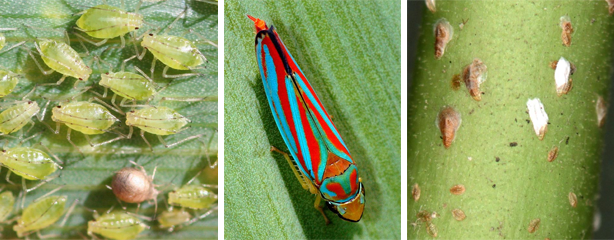
Common Homoptera in the urban landascape: Tulip Bulb Aphid (Whitney Cranshaw, Colorado State University, Bugwood.org), Redbanded Leafhopper (Susan Ellis, Bugwood.org), Euonymous Scales (Lorraine Graney, Bartlett Tree Experts, Bugwood.org)
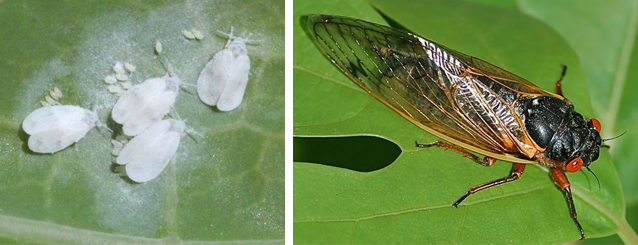
Sweetpotato Whitefly (Lesley Ingram, Bugwood.org) and Periodical Cicada (Jon Yuschock, Bugwood.org)
NEXT:
